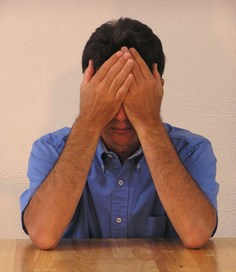
Image: Flickr user Dyanna
Computers and eyes don’t get along. If you frequently stare at a screen, chances are you’ll eventually feel symptoms of computer-related eye strain (also called Computer Visions Syndrome). According to Dr. Marc Grossman, who runs Natural Eye Care, our eyes are designed for hunting, which involves seeing danger or potential food from far away. Staring for hours at an unmoving screen just isn’t something we’re adapted to do.
To protect your eyes from strain, first make sure that you monitor’s contrast, refresh rate, and height are properly adjusted. Once you’ve done that, try these five tricks to keep your eyes healthy:
1. Take Breaks

Look away from your computer every half hour. Give your eyes a rest by gazing at a distant object. Better yet, physically get up and move around for five minutes.
According to Dr. Marc Grossman, a prominent New York-based eye care specialist,
Short, frequent breaks are better than long, infrequent breaks. Try 2-3 minutes every 15-20 minutes, 5 minutes every 30 minutes, or 10 minutes every hour.
2. Look Away

Larry K. Wan, OD of All About Vision recommends a brief, easy exercise to keep your eyes from something called accomodative spasm, in which the eye gets stuck in one focus mode (eg. close objects) and can’t focus on more distant objects:
Look far away at an object for 10-15 seconds, then gaze at something up close for 10-15 seconds. Then look back at the distant object. Do this 10 times. This exercise reduces the risk of your eyes’ focusing ability to “lock up” (a condition called accommodative spasm) after prolonged computer work.
3. Palm

Relax your eyes and nervous system with palming, a yogic technique said to preserve eye health. Rub your hands together vigorously. Once your palms are hot from the friction, gently cup them over your eyes, overlapping your fingers on your forehead. Do not press on the eyes. Breathe deeply and relax for at least 30 seconds. You’ll feel refreshed after doing this exercise for even a short time.
4. Acupressure

Image: EyesandEyesight
Acupressure is said to relieve headaches, itching, burning eyes, and tension. Seattle’s Bastyr Center lists a simple eye acupressure massage sequence:
1. Cradling the forehead, with finger tips at the hairline and thumb tips at the inner corners of the eyebrows, apply a circular pressure and knead these acu-points. This benefits the eyes and vision, relieves frontal headaches, quells itching and burning in the eyes and may even relieve neck pain.
2. With eyes closed, use your thumb or forefinger to knead in an up and down motion just above the inner corner of each eye. Knead deeply enough so that light circles are visible on the inner eyelids.
3. Directly below the pupils on the orbital bones (bones parallel to the bridge of the nose) a small depression is palpable on each side of the face. Knead these points with a circular pressure.
4. Finally, rest your thumbs on your temples and use the knuckle of the forefinger to drag along the length of the eyebrows. Similarly, drag the knuckle along the lower ocular bones from the bridge of the nose to the lateral corners of the eye sockets. Repeat this stroke and feel the tension around your eyes drain away.
5. Blink
People blink about five times less than normal when they’re working at a computer, writes All About Vision’s Dr. Wan. Dry, irritated eyes result. Remember to blink when you’re staring at a screen. Or try blinking exercises. Wan recommends this one:
Every 20 minutes, blink 10 times by closing your eyes as if falling asleep (very slowly). This will help rewet your eyes.
